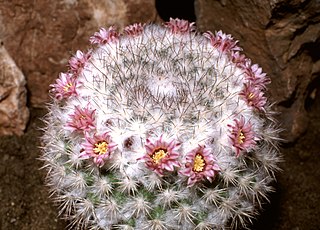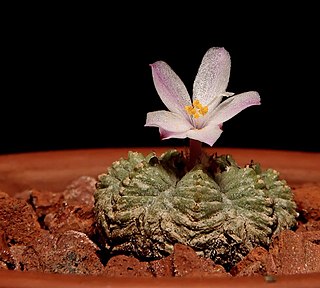
Mammillaria is one of the largest genera in the cactus family (Cactaceae), with currently 200 known species and varieties recognized. Most of the mammillarias are native to Mexico, while some come from the Southwestern United States, the Caribbean, Colombia, Guatemala, Honduras and Venezuela. The common name "pincushion cactus" refers to this genus and the closely-related Escobaria.

Fishhook cactus is a common name for any hook-spined species of the genera Mammillaria, Echinomastus, Sclerocactus, or Cochemiea. They are small cacti, usually growing up to 6-7 inches (20 cm) high, and are shaped similar to a barrel cactus. They are not to be confused with the fishhook barrel cactus of the Sonoran and Chihuahuan Deserts. The Fishhook cactus is a large category of around 150 species.

Echinocereus engelmannii, the strawberry hedgehog cactus or Engelmann's hedgehog cactus, is a cactus commonly found in desert areas of the southwestern United States and the adjacent areas of Mexico, including the states of California, Nevada, Utah, Arizona, Baja California and Sonora.

Cochemiea dioica, also called the strawberry cactus, California fishhook cactus, strawberry pincushion or fishhook cactus, is a cactus species of the genus Cochemiea. Its common name in Spanish is biznaga llavina.
Mammillaria herrerae is a species of plant in the family Cactaceae. It is endemic to Mexico where it is confined to Querétaro. It thrives in a semi-desert shrubland habitat. Common name is golf ball cactus. It is threatened by habitat loss and illegal collection. In a 20-year period over 95% of the species population was illegally collected or sold. Mammillaria herrerae has an IUCN rating of critically endangered. Due to its specific growing conditions, there is a challenge in propagating. Many studies are being done to determine best growing conditions, through related species.

Aztekium ritteri is a species of cactus native to the Mexican state of Nuevo León.

Mammillaria rhodantha, the rainbow pincushion, is a plant in the cactus family (Cactaceae) and is one of 171 species in the genus Mammillaria which are characterized by having nipple-shaped tubercles or prominences on their surface.

Mammillaria elongata, the gold lace cactus or ladyfinger cactus, is a species of flowering plant in the family Cactaceae, native to central Mexico. Growing to 15 cm (6 in) tall by 30 cm (12 in) wide, it consists of densely packed clusters of elongated oval stems, covered in harmless yellow or brown spines, and in spring producing white or yellow flowers. It is among the most common and most variable of its genus in nature, and is a popular subject for cultivation. It has gained the Royal Horticultural Society's Award of Garden Merit.

Mammillaria spinosissima, also known as the spiny pincushion cactus, is a species of flowering plant in the cactus family Cactaceae, endemic to the central Mexican states of Guerrero and Morelos, where they grow at elevations of approximately 1,600 to 1,900 metres. The species was described in 1838 by James Forbes, gardener of the Duke of Bedford. Botanist David Hunt collected a specimen in 1971, when he located one near Sierra de Tepoztlan, Mexico.

Cochemiea tetrancistra is a species of fishhook cactus known by the common name common fishhook cactus. It is native to the Mojave and Sonoran Deserts of northern Mexico and the southwestern United States, where it grows in a variety of desert habitat types.

Pelecyphora sneedii is a rare species of cactus known by the common names Sneed's pincushion cactus and carpet foxtail cactus. It is endemic to the Chihuahuan Desert of the southwestern United States and northwestern Mexico. It is a small, variable cactus with a lengthy taxonomic history, and is often subdivided into a number of subspecies or varieties. It is usually found on steep, rocky habitats, primarily of limestone geology, in desert scrub or coniferous forest. A species of conservation concern, P. sneedii faces threats from poaching, urban encroachment, and wildfires.

Ferocactus peninsulae is a barrel cactus in the genus Ferocactus of the family Cactaceae.

Cochemiea thornberi is a species of cactus known by the common names Thornber's fishhook cactus and Thornber's nipple cactus. It is native to Arizona in the United States and Sonora in Mexico.

Mammillaria morganiana, common name owl's eyes or owl-eye pincushion, is a cactus in the genus Mammillaria of the family Cactaceae. The epithet morganiana honors the U.S. optometrist Meredith Walter Morgan (1887-1957) of Richmond.

Mammillaria marksiana is a cactus in the genus Mammillaria of the family Cactaceae.

Mammillaria grusonii is a cactus in the genus Mammillaria of the family Cactaceae. The epithet grusonii honors the inventor, scientist, industrialist and cacti collector Hermann Gruson of Magdeburg.

Mammillaria magnimamma, common name Mexican pincushion, is a species of flowering plant in the cactus family Cactaceae.

Mammillaria plumosa, the feather cactus, is a species of flowering plant in the family Cactaceae, native to Northeastern Mexico.

Cochemiea grahamii is a species of cactus also known by the names Arizona fishhook cactus and Graham's nipple cactus.

Cochemiea mainiae is a species of cactus in the subfamily Cactoideae, with the common name counterclockwise nipple cactus.



















